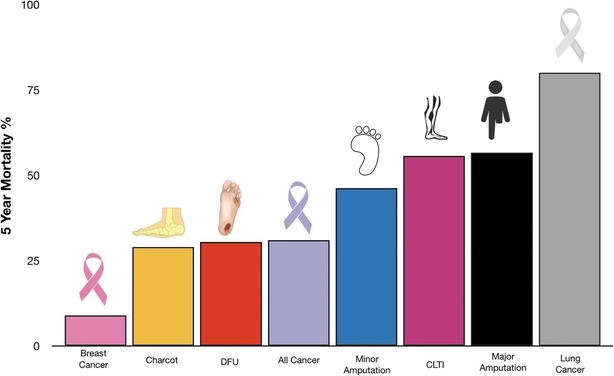Analysis: In Ireland, the risk of limb amputation is 22 times higher than average in people with diabetes. What are we doing to prevent it?
By Jennifer Pallin, UCC; Lauren Connell and Chloe Hobbs, University of Galway
Globally, around 537 million adults are living with diabetes mellitus, and this is set to increase to 643 million by 2030 and 783 million by 2045. Did you know that diabetes mellitus can lead to complications that cause leg amputations? Indeed, every 20 seconds someone in the world undergoes a leg amputation due to diabetes mellitus. Yet, for many people this is avoidable. Here, we discuss diabetes-related limb amputations, the impact it can have on the people affected and what we can do to prevent it.
In Ireland, the risk of limb amputation is 22 times higher than average in people with diabetes mellitus. Limb amputation has negative impacts on the person affected, including an increased risk of depression and anxiety, and on healthcare systems. A recent study in the United States found that 30.5% of people diagnosed with a diabetic foot ulcer die after five years, compared to 31% of people dying after a cancer diagnosis. Alarmingly, the rate of death after five years rises to 46.2% after minor amputations and 56.6% after major amputations.
What leads to limb loss in people with diabetes?
In most cases limb loss does not just happen, and there are specific signs (or risk factors) that we can look out for. This is also referred to as screening. Risk factors include loss of feeling, reduced blood flow and deformity, and all of these, separately and combined, cause ulcers to develop in the feet and increase a person's risk of limb loss. The term "stairways to amputation" is often used to describe a person’s progression towards amputation.
We need your consent to load this rte-player contentWe use rte-player to manage extra content that can set cookies on your device and collect data about your activity. Please review their details and accept them to load the content.Manage Preferences
From RTÉ Radio 1's Morning Ireland, Professor Carel Le Roux, Obesity Specialist at St Vincent's University Hospital, explains how the Type 2 diabetes surgery works
What can we do to prevent diabetes mellitus-related limb loss?
We know that early identification of risk factors, and timely treatment and management of ulcers, significantly reduces a person’s risk of amputation. However, there is no one simple method. Prevention requires the involvement of many healthcare professionals, working with the individual, to support them in accessing:
- Appropriate education on the risk of diabetes mellitus to the lower limbs.
- Screening for risk factors for ulceration and amputation.
- Referral to appropriate health services, including podiatry, to manage risk factors.
- Treatment strategies to help ulcers heal and to prevent progression to amputation.
In Ireland, it is recommended that a person with diabetes mellitus has their feet screened at least once a year. This can be done by their GP/practice nurse or a member of their diabetes team in the hospital. If risk factors are identified they should be seen by a podiatrist in their local primary care centre, and if they have an ulcer, they should be seen by a team of different specialists working together in a hospital.

Members of the "Diabetic Foot Disease, Prevention and Management to Improve Patient Outcomes" (DFD-PRIMO) team based at University of Galway and University College Cork are working on different aspects of diabetic foot care to improve the patient care. Recognising the need for improved prevention and treatment strategies, their research is focused on improving patient education and well-being, access to annual diabetic foot screening, wound assessment, and improved wound treatments. The DFD-PRIMO team are funded through the Health Research Board, the Irish Research Council, and the Hardiman Scholarship from the University of Galway.
If you are concerned about your risk of ulceration or amputation, more information is available here and here. You can also talk to your GP or a member of your diabetes care team.
This project is funded by the Health Research Board as part of the DFD PRIMO collaborative doctoral award.
Jennifer Pallin is a third year PhD student in the School of Public Health, University College Cork. Lauren Connell is a practising podiatrist and a third year PhD student in the Department of Health Promotion, University of Galway. Chloe Hobbs is a third year Microbiology PhD student in the School of Biological and Chemical Sciences, University of Galway.
The views expressed here are those of the author and do not represent or reflect the views of RTÉ

